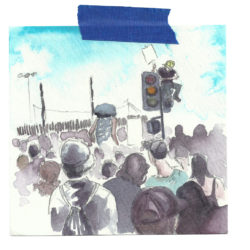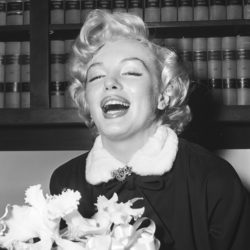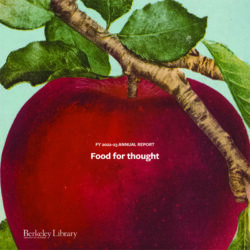©
1923
The floodgates have opened: The moment the new year arrived, hundreds of thousands of works published in 1923 came rushing into the public domain in a mass expiration of copyrights observed as Public Domain Day. With a huge new crop of materials now copyright-free, the UC Berkeley Library digitized more than 50 of them from its collections and made them available for the world to use. (See a complete list of what the Library has digitized for Public Domain Day.) From art to architecture, poetry to photography, each work is a freeze-frame of a moment in time, providing a plethora of possibilities for scholars — and anyone who wants to explore the knowledge that lies within. To learn more about an item, click on an image below. Read more about Public Domain Day on Library News.
Among the most beautiful items to grace the public domain this year is an album of woodcut prints by the Japanese artist Teikichi Hikoyama, who came to San Francisco in 1901. Hikoyama was a member of the San Francisco Art Association and held exhibitions at museums such as the San Francisco Museum of Art, now SFMOMA, and the California Palace of the Legion of Honor. This album contains 26 black-and-white woodcut prints, each highly detailed and striking. The scenes — with symbolic titles such as Rising Sun, Song of Spring, and Moonlit Sea — are by turns powerful, whimsical, and enchanting. One of the earliest forms of printmaking, woodcuts involve carving an image into a block of wood, cutting away the portions that will not receive ink. After carving the design, an artist rolls ink over the block, coloring only the parts still level with the surface. Paper is then laid over the block to absorb the design. For Lynn Cunningham, campus art librarian, freeing artwork such as woodcut prints will be a “boon to the field of art history.” Researchers must often pay expensive fees to reproduce art in books and articles, she said, which can be prohibitive. “These public domain images are part of our shared cultural heritage, so it is exciting to have them become available for unrestricted use,” she said. “As works move into the public domain, it has the potential to open up scholarship and enhance our collective understanding.”














Rec. no: b13227253
Emanuel Fritz occupies a special place in the history of forestry at UC Berkeley. Known as “Mr. Redwood,” Fritz was an authority on and professor of forestry at UC Berkeley for more than three decades, starting in 1919 and retiring in 1954, and was integral to the program’s development. (At the time of his death, in 1988, Fritz was an emeritus professor and, at 102, reportedly the longest-living professor at UC Berkeley.) “Properties and Uses of Second-Growth Redwood” is a never-before-published report, made available in digital form by the Library, that details an investigation for the UC College of Agriculture’s Agricultural Experiment Station. (“Second growth,” as opposed to “old growth,” refers to the generation of trees that crop up after the previous generation has been logged or otherwise wiped out.) The UC Berkeley Library is the only library known to have the report, believed to be the original copy. “The results of the study were meant to provide foresters with information regarding how the wood of second-growth redwood compared to wood from old-growth trees,” said Becky Miller, natural resources and environmental sciences librarian. The report features hand-drawn figures and maps (including foldouts) and dozens of fascinating original photographs. “As far as the research, it contributed to the development of the second-growth redwood lumber industry,” Miller said. The Library also holds Fritz’s papers, as well as the Metcalf-Fritz photographic collection, which consists of about 9,000 photos dating between 1906 and 1984 that highlight forestry, conservation, and the lumber industry. Fritz and Woodbridge Metcalf, a fellow forestry faculty member, shot most of the photos themselves.










Rec. no: b12887498
Julia Morgan and Bernard Maybeck designed them. Sears sold them in kits. Steve Jobs and Steve Wozniak founded Apple in one. Bungalow-mania hit the United States around the turn of the past century, as families clamored for homes that were both beautiful and budget-friendly. But the bungalow’s beginnings go back way further than that. “The low-slung homes that colonized sun-drenched California suburbs in the first decades of the 20th century trace their origins to early-17th century South Asia,” said Greg Castillo, associate professor in UC Berkeley’s Department of Architecture. The one-story, thatched hut known as a “bangala” in Hindi took root in English coastal resorts by the mid-19th century as a modest cottage, swapping bamboo for brick. Soon, colonial Africa, Australia and New Zealand, and the United States had hybrids of their own, according to Castillo. Beautiful Bungalows, one of the books the Library has made available for Public Domain Day, showcases examples of these homes from across the continental United States, from California to Florida, Arizona to New York. “By releasing Beautiful Bungalows into the public domain, the UC Berkeley Library brings the history of this global dwelling type full circle,” Castillo said. “Through digitization and distribution in the public domain, readers on every continent may now enjoy a guide to the bungalow’s conquest of America ‘from Maine to California,’ thanks to an initiative by librarians at Berkeley.”










Rec. no: b14584122
The year was 1923. Alcohol was outlawed across the country, and women had only recently been given the right to vote. Also that year, a pair of American women, Ednah Aiken and Elinor Wylie, published two important works that shed light on life in that climate. Aiken, a Berkeley alum born in San Francisco, released the novel If Today Be Sweet, which is set in the Bay Area and dramatizes the political and social costs of Prohibition. (UC Berkeley is mentioned at the start of the story.) Aiken’s papers are held by The Bancroft Library. “Aiken is noteworthy for her contributions to California regional literature and women’s writing, and she is a bright light in Cal history,” said Stacy Reardon, literatures and digital humanities librarian. “While the novel’s limited availability has made access challenging in the past, Aiken’s book will now be available to the world.” The second work, Black Armour, is a collection of poems by Elinor Wylie — a poet and novelist who had trained for life as a debutante on the East Coast but rebelled as an outspoken writer, infamous for a series of affairs and scandals. (The year Black Armour was published, Wylie divorced her second husband to marry a third. After the wedding, a friend remarked, “But if you marry again, shall cut you dead — and I warn you all Society will do the same. You will be nobody.”) Wylie was a celebrated poet and a leading figure in New York City literary circles. Wylie often wrote about the restraints of traditional womanhood. Black Armour is a collection of intimate, sometimes dark, portrayals of humanity and love but also a picture of the author’s formidable strength.








If Today Be Sweet: Rec no. b10001557 Black Armour: Rec no. b10480135
On Sept. 17, 1923, a cataclysmic fire swept through Berkeley, devouring 600 homes and burning down entire blocks downtown in just a few short hours. The fire, whose exact cause is unknown, began in the undeveloped shrubbery of Wildcat Canyon and was pushed over the Berkeley hills and into the city by strong gusts of dry wind. “People were talking casually about forest fires … when news came of the blaze threatening Mills College … above East Oakland,” tells the introduction to the 1923 work, The Berkeley Fire, now publicly available. “And they were still talking of this when they saw the long vicious tongues of flame coiling into the very heart of their own city, and stood appalled before a towering billow of smoke that poured heavenward like the reek of some gigantic altar in Biblical story.” A series of photographs now digitized show buildings burning on Shattuck Avenue, Spruce Street, and other blocks, along with efforts by community members, including students, to fight the fires. According to Scott Stephens, a campus professor of fire science, the 1923 fire was one of the first fires in California’s history to occur at the wildland-urban interface — the zone in which human development has encroached upon wildland prone to wildfire. Since 1923, many more fires have burned at this intersection, including the 1991 fire in the Oakland hills and, most recently, the Camp Fire in Butte County. “The photos of the (1923) fire, nearly 100 years old, help communicate still the dangers of building at the wildland-urban interface,” said Tarek Zohdi, a professor of mechanical engineering and head of UC Berkeley’s Fire Research Group. “We do not learn, and the infrastructure is as unsafe as before.”








BANC PIC 1987.056--PIC




